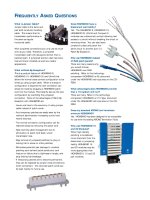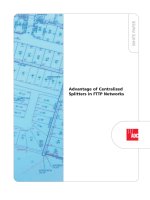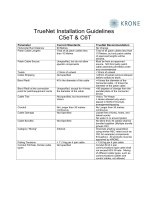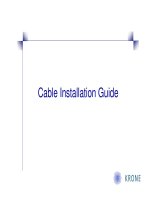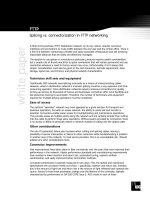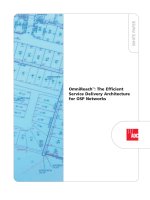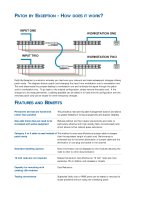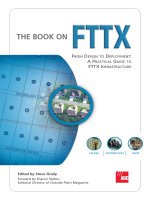Pressure Vessels Guide Book ppt
Bạn đang xem bản rút gọn của tài liệu. Xem và tải ngay bản đầy đủ của tài liệu tại đây (3.88 MB, 279 trang )
1
Chapter
1
Origin, Development,
and Jurisdiction
of the ASME Code
History of the ASME Code
On March 20, 1905, a disastrous boiler explosion occurred in a shoe fac-
tory in Brockton, Massachusetts, killing 58 persons, injuring 117 others,
and causing a quarter of a million dollars in property damage. For years
prior to 1905, boiler explosions had been regarded as either an inevitable
evil or “an act of God” (see Figs. 1.1 and 1.2). But this catastrophic acci-
dent had the effect of making the people of Massachusetts see the neces-
sity and desirability of legislating rules and regulations for the
construction of steam boilers in order to secure their maximum safety.
After much debate and discussion, the state enacted the first legal code
of rules for the construction of steam boilers in 1907. In 1908, the state
of Ohio passed similar legislation, the Ohio Board of Boiler Rules adopt-
ing, with a few changes, the rules of the Massachusetts Board.
Therefore, other states and cities in which explosions had taken
place began to realize that accidents could be prevented by the proper
design, construction, and inspection of boilers and pressure vessels and
began to formulate rules and regulations for this purpose. As regula-
tions differed from state to state and often conflicted with one another,
manufacturers began to find it difficult to construct vessels for use in
one state that would be accepted in another. Because of this lack of uni-
formity, both manufacturers and users made an appeal in 1911 to the
Council of the American Society of Mechanical Engineers to correct the
situation. The Council answered the appeal by appointing a committee
“to formulate standard specifications for the construction of steam boil-
ers and other pressure vessels and for their care in service.”
Downloaded from Digital Engineering Library @ McGraw-Hill (www.digitalengineeringlibrary.com)
Copyright © 2004 The McGraw-Hill Companies. All rights reserved.
Any use is subject to the Terms of Use as given at the website.
Source: Pressure Vessels
2 Chapter One
Figure 1.1 The Brockton, Massachusetts, shoe factory. (Courtesy of The Hartford Steam
Boiler Inspection and Insurance Company.)
The first committee consisted of seven members, all experts in their
respective fields: one boiler insurance engineer, one material manufac-
turer, two boiler manufacturers, two professors of engineering, and one
consulting engineer. The committee was assisted by an advisory com-
mittee of 18 engineers representing various phases of design, con-
struction, installation, and operation of boilers.
Following a thorough study of the Massachusetts and Ohio rules
and other useful data, the committee made its preliminary report in
1913 and sent 2000 copies of it to professors of mechanical engineer-
ing, engineering departments of boiler insurance companies, chief
inspectors of boiler inspection departments of states and cities, man-
ufacturers of steam boilers, editors of engineering journals, and oth-
ers interested in the construction and operation of steam boilers, with
a request for suggestions of changes or additions to the proposed reg-
ulations.
After three years of countless meetings and public hearings, a final
draft of the first ASME Rules for Construction of Stationary Boilers
and For Allowable Working Pressures, known as the 1914 edition, was
adopted in the spring of 1915.
Origin, Development, and Jurisdiction of the ASME Code
Downloaded from Digital Engineering Library @ McGraw-Hill (www.digitalengineeringlibrary.com)
Copyright © 2004 The McGraw-Hill Companies. All rights reserved.
Any use is subject to the Terms of Use as given at the website.
Origin, Development, and Jurisdiction of ASME Code 3
Additions to the Code
Since 1914, many changes have been made and new sections added to
the Code as the need arose. The present sections are listed in the fol-
lowing order:
Section I. Power Boilers
Section II. Materials
Part A: Ferrous Material Specifications
Part B: Nonferrous Material Specifications
Part C: Specifications for Welding, Rods, Electrodes, and Filler
Metals
Part D: Properties
Section III. Rules for Construction of Nuclear Components
Subsection NCA: General Requirements for Divisions 1 and 2
Division 1
Subsection NB: Class 1 Components
Subsection NC: Class 2 Components
Subsection ND: Class 3 Components
Subsection NE: Class MC Components
Subsection NF: Supports
Figure 1.2 Shoe factory after the boiler explosion of March 20, 1905, which led to the adop-
tion of many state boiler codes and the ASME Boiler and Pressure Vessel Code. (Courtesy
of The Hartford Steam Boiler Inspection and Insurance Company.)
Origin, Development, and Jurisdiction of the ASME Code
Downloaded from Digital Engineering Library @ McGraw-Hill (www.digitalengineeringlibrary.com)
Copyright © 2004 The McGraw-Hill Companies. All rights reserved.
Any use is subject to the Terms of Use as given at the website.
4 Chapter One
Subsection NG: Core Support Structures
Subsection NH: Class 1 Components in Elevated Temperature
Service
Appendices
Division 2. Code for Concrete Containments
Division 3. Containment Systems for Storage and Transport
Packaging of Spent Nuclear Fuel and High Level Radioactive
Materials and Waste
Section IV. Heating Boilers
Section V. Nondestructive Examination
Section VI. Recommended Rules for Care and Operation of Heating
Boilers
Section VII. Recommended Guidelines for the Care of Power Boilers
Section VIII. Pressure Vessels
Division 1
Division 2. Alternative Rules
Division 3. Alternative Rules for Construction of High Pressure
Vessels
Section IX. Welding and Brazing Qualifications
Section X. Fiber-Reinforced Plastic Pressure Vessels
Section XI. Rules for Inservice Inspection of Nuclear Power Plant
Components
ASME Boiler and Pressure Vessel Committee
The increase in the size of the Code reflects the progress of industry in
this country. To keep up with this spontaneous growth, constant revi-
sions have been required. The ASME Code has been kept up to date by
the Boiler and Pressure Vessel Committee (currently consisting of
more than 800 volunteer engineers and other technical professionals)
which considers the needs of the users, manufacturers, and inspectors
of boilers and pressure vessels. In the formulation of its rules for the
establishment of design and operating pressures, the Committee con-
siders materials, construction, methods of fabrication, inspection, cer-
tification, and safety devices. The ASME works closely with the
American National Standards Institute (ANSI) to assure that the
resulting documents meet the ANSI criteria for publication as
American National Standards.
The members of the Committee do not represent particular organi-
zations or companies but have recognized background and experience
Origin, Development, and Jurisdiction of the ASME Code
Downloaded from Digital Engineering Library @ McGraw-Hill (www.digitalengineeringlibrary.com)
Copyright © 2004 The McGraw-Hill Companies. All rights reserved.
Any use is subject to the Terms of Use as given at the website.
Origin, Development, and Jurisdiction of ASME Code 5
by which they are placed in categories, which include manufacturers,
users of the products for which the codes are written, insurance
inspection, regulatory, and general. The Committee meets on a regu-
lar basis to consider requests for interpretations and revisions and
additions to Code rules as dictated by advances in technology.
Approved revisions and additions are published semiannually as
addenda to the Code.
To illustrate, boilers were operating in 1914 at a maximum pressure
of 275 psi and temperature of 600°F. Today, boilers are designed for
pressures as high as 5000 psi and temperatures of 1100°F, and pres-
sure vessels for pressures of 3000 psi and over and for temperatures
ranging from –350°F to more than 1000°F.
Each new material, design, fabrication method, and protective device
brought new problems to the Boiler Code Committee, requiring the
expert technical advice of many subcommittees in order to expedite
proper additions to and revisions of the Code. As a result of the splen-
did work done by these committees, the ASME Boiler and Pressure
Vessel Code has been developed; it is a set of standards that assures
every state of the safe design and construction of all boiler and pressure
vessels used within its borders and is used around the world as a basis
for enhancing public health, safety, and welfare. Many foreign manu-
facturers are accredited under the provisions of the ASME Boiler and
Pressure Vessel Code.
Procedure for Obtaining the Code Symbol
and Certificate
Users of pressure vessels prefer to order ASME Code vessels because
they know that such vessels will be designed, fabricated, and inspected
to an approved quality control system in compliance with a safe stan-
dard. Pressure vessel manufacturers want the Code symbol and
Certificate of Authorization so that they will be able to bid for Code
work, thereby broadening their business opportunities. They also
believe that authorization to build Code vessels will enhance the repu-
tation of their shop.
If a company is interested in building Code vessels according to the
ASME Section VIII, Division 1, Pressure Vessels Code, it should
acquaint itself with Code Pars. U-2 and UG-92, which outline the manu-
facturer’s responsibilities and define the requirements for an inspector.
This third party in the manufacturer’s plant, by virtue of being autho-
rized by the state to do Code inspection, is the legal representation which
permits the manufacturer to fabricate under state laws (the ASME Code).
Manufacturers who want to construct Code vessels covered by
Section VIII, Division 1, obligate themselves with respect to quality
Origin, Development, and Jurisdiction of the ASME Code
Downloaded from Digital Engineering Library @ McGraw-Hill (www.digitalengineeringlibrary.com)
Copyright © 2004 The McGraw-Hill Companies. All rights reserved.
Any use is subject to the Terms of Use as given at the website.
6 Chapter One
and documentation (see Code Appendix 10, Quality Control Systems).
A survey will be required for the initial issuance of an ASME
Certificate of Authorization and for each renewal. The evaluation is
performed jointly by the Authorized Inspection Agency and the juris-
dictional authority concerned which has adopted, and also administers,
the applicable boiler and pressure vessel legislation. When the juris-
dictional authority does not make the survey, or the jurisdiction is the
inspection agency, the National Board of Boiler and Pressure Vessel
Inspectors will be asked to participate in the survey.
After the survey has been jointly made to establish that a quality
control system is actually in practice, the National Board representa-
tive, if involved, and the jurisdiction authority will discuss their find-
ings with the manufacturer. If the manufacturer’s system does not
meet Code requirements, the company will be asked to make the nec-
essary corrections. The survey team will then forward its report to the
ASME with the recommendation that the manufacturer receive the
Certificate of Authorization or, if failure to meet standards exists, that
the certificate not be issued.
All Code shops must follow the above procedures in order to obtain
the Code symbol. If your shop wants the Code Certificate of Auth-
orization, you should write to the Secretary of the Boiler and Pressure
Vessel Code Committee, ASME, 3 Park Avenue, New York, NY
10016-5990, stating your desire to build such vessels. To help the sec-
retary and the Subcommittee on Code Symbol Stamps evaluate your
shop, the application must describe the type and size of vessel the
shop is capable of building and the type and size of your equipment,
especially fabricating equipment. If possible, you should arrange with
some Authorized Inspection Agency, such as your state, city, or insur-
ance company, to undertake the inspection service after your shop
has received ASME certification. You can then inform the ASME that
specific inspection arrangements have already been made.
The secretary will send a statement of your request to the Subcom-
mittee on Code Symbol Stamps. A request will also be made to the chief
inspector of the particular state, city, or other inspection agency gov-
erning your company and/or the National Board of Boiler and Pressure
Vessel Inspectors to make a survey that will determine whether or not
your company has a quality control system that is capable of designing
and fabricating pressure vessels by ASME Code rules.
The secretary receives a report of this survey and will then forward
the report to the Subcommittee on Code Symbol Stamps. Should the
subcommittee judge favorably, your company will be issued a Code sym-
bol and Certificate of Authorization. A manufacturer with the ability,
integrity, and quality control system to design and fabricate good pres-
sure vessels will have no difficulty in obtaining Code authorization.
Origin, Development, and Jurisdiction of the ASME Code
Downloaded from Digital Engineering Library @ McGraw-Hill (www.digitalengineeringlibrary.com)
Copyright © 2004 The McGraw-Hill Companies. All rights reserved.
Any use is subject to the Terms of Use as given at the website.
Origin, Development, and Jurisdiction of ASME Code 7
The National Board of Boiler and
Pressure Vessel Inspectors
The National Board of Boiler and Pressure Vessel Inspectors, an inde-
pendent, nonprofit organization whose members are the jurisdictional
officials responsible for enforcing and administrating the ASME Boiler
and Pressure Vessel Code, was first organized in 1919. Since then, it
has served for the uniform administration and enforcement of the rules
of the ASME Boiler and Pressure Vessel Code. In drafting the first
Code, the Boiler Code Committee realized that it had no authority to
write rules to govern administration, and that compliance could be
made mandatory only by the legislative bodies of states and cities.
Although some authorities thought that uniformity could be
achieved by a code of uniform rules, they proved to be mistaken.
Various states and cities adopted the ASME Code with the provision
that boilers be inspected during construction by an inspector qualified
under their own regulations; the boiler was then to be stamped with
the individual local stamping to indicate its conformity with these reg-
ulations. This requirement created an unwieldy situation, for boilers
constructed in strict accordance with the ASME Code still had to be
stamped with the local stamping, thereby causing needless delay and
expense in delivery of the vessel.
It was evident that some arrangement had to be made to overcome
such difficulties. Therefore, boiler manufacturers met with the chief
inspectors of the states and cities that had adopted the ASME Code and
formed the National Board of Boiler and Pressure Vessel Inspectors for
the purpose of presenting the ASME Code to governing bodies of all
states and cities. Their aim was not only to promote safety and unifor-
mity in the construction, installation, and inspection of boilers and
pressure vessels but also to establish reciprocity between political sub-
divisions of the United States. Such ideals could best be carried out by
a central organization under whose auspices chief inspectors, or other
officials charged with the enforcement of inspection regulations, could
meet and discuss their problems. The efforts of this first group of
administrators succeeded in extending National Board membership to
all Canadian provinces and most of the states and cities of the United
States. It is now possible for an authorized shop to build a boiler or
pressure vessel that will be accepted anywhere in the United States or
Canada after it has been inspected by an Authorized Inspector holding
a National Board Commission.
The ASME Code requires that Inspectors must meet certain mini-
mum requirements of education and experience and must pass a writ-
ten examination before they can be commissioned to perform Code
inspections. One of the many functions of the National Board is the
commissioning of Authorized Inspectors.
Origin, Development, and Jurisdiction of the ASME Code
Downloaded from Digital Engineering Library @ McGraw-Hill (www.digitalengineeringlibrary.com)
Copyright © 2004 The McGraw-Hill Companies. All rights reserved.
Any use is subject to the Terms of Use as given at the website.
8 Chapter One
Shop Reviews by the National Board
Before the issuance of an ASME Certificate of Authorization to build
Code vessels, the manufacturer must have and demonstrate a quality
control system. This system has to include a written description
explaining in detail the quality-controlled manufacturing process.
Before the issuance of renewal of a Certificate of Authorization, the
manufacturer’s facilities and organization are subject to a joint review
by the inspection agency and the legal jurisdiction concerned. For those
areas where there is no jurisdiction, or where a jurisdiction does not
review a manufacturer’s facility, and/or the jurisdiction is the inspec-
tion agency, the function may be carried out by a representative of the
National Board of Boiler and Pressure Vessel Inspectors. When the
review of the manufacturer’s facilities and organization has been made
jointly by the inspection agency, and/or the legal jurisdiction, or a rep-
resentative of the National Board of Boiler and Pressure Vessel
Inspectors, a written report will be sent to the American Society of
Mechanical Engineers. The National Board of Boiler and Pressure
Vessel Inspectors also participates in all nuclear surveys.
The National Board also issues Certificates of Authorization for the
use of the National Board R stamp, to be applied to ASME Code and
National Board–stamped boilers and/or pressure vessels on which
repairs are to be made (see the section Welded Repair or Alteration
Procedure in this chapter).
Another important service the National Board performs is the certifi-
cation of safety valves and safety relief valves. The ASME Boiler and
Pressure Vessel Code contains specific requirements governing the de-
sign and capacity certification of safety valves installed on Code-stamped
vessels. The certification tests are conducted at a testing laboratory
approved by the ASME Boiler and Pressure Vessel Committee.
In addition to safety valve certification, the National Board has its
own testing laboratory for its experimental work and for certifying
ASME safety and relief valves. The facilities of the laboratory are also
available to manufacturers and other organizations for research, devel-
opment, or other test work.
National Board Requirements
All Canadian provinces and most states require boilers and pressure
vessels to be inspected during fabrication by an Inspector holding a
National Board Commission and then to be stamped with a National
Board standard number. Qualified and authorized boiler and pressure
vessel manufacturers must be registered with the National Board of
Boiler and Pressure Vessel Inspectors, 1055 Crupper Ave., Columbus,
OH 43229. In addition, two data sheets on each vessel must be filed
Origin, Development, and Jurisdiction of the ASME Code
Downloaded from Digital Engineering Library @ McGraw-Hill (www.digitalengineeringlibrary.com)
Copyright © 2004 The McGraw-Hill Companies. All rights reserved.
Any use is subject to the Terms of Use as given at the website.
Origin, Development, and Jurisdiction of ASME Code 9
with the National Board, one copy of which is retained by the Board
and the other sent to the administrative authority of the state, city, or
province in which the vessel is to be used (see Code Par. UG-120).
The National Board of Boiler and Pressure Vessel Inspectors is con-
stantly working to assure greater safety of life and property by pro-
moting and securing uniform enforcement of boiler and pressure vessel
laws and uniform approval of designs and structural details of these
vessels, including the accessories that affect their safe operation; by
furthering the establishment of a uniform Code; by espousing one stan-
dard of qualifications and examinations for inspectors who are to
enforce the requirements of this Code; and by seeing that all relevant
data of the Code are made available to members.
In prior years the Uniform Boiler and Pressure Vessel Laws Society
issued a Synopsis of Boiler and Pressure Vessel Laws, Rules, and
Regulations, the publishing of which has been assumed by the National
Board. The book gives a summary of applicable laws of states,
provinces, cities, and counties. It has proved valuable to users and
manufacturers of boilers and pressure vessels. Figures 1.3 and 1.4
show political subdivisions of the United States and Canada.
Code Case Interpretations
As the Code does not cover all details of design, construction, and mate-
rials, pressure vessel manufacturers sometimes have difficulty in
interpreting it when trying to meet specific customer requirements. In
such cases the Authorized Inspector should be consulted. If the
Inspector is unable to give an acceptable answer or has any doubts or
questions about the proper interpretation of the intent of the Code, the
question can be referred to the Inspector Supervisor’s office. If the
Inspector and his or her supervisor are not able to provide a ruling,
the manufacturer may then request the assistance of the Boiler and
Pressure Vessel Committee, which meets regularly to consider
inquiries of this nature. In referring questions to the Boiler and
Pressure Vessel Committee, it is necessary to submit complete details,
sketches of the construction involved, and references to the applicable
paragraphs of the Code; it is also useful to include opinions expressed
by others. (See Code Appendix 16 for guidance in preparing inquiries
to the ASME.)
Inquiries should be submitted by letter to the Secretary of the Boiler
and Pressure Vessel Committee, ASME, 3 Park Avenue, New York, NY
10016-5990. (It should be noted that with the advent of the Internet,
much of this work can be accomplished through the Web. The ASME
can be found at www.asme.org.) The secretary will distribute copies of
the inquiry to the committee members for study. At the next commit-
tee meeting, interpretations will be formulated.
Origin, Development, and Jurisdiction of the ASME Code
Downloaded from Digital Engineering Library @ McGraw-Hill (www.digitalengineeringlibrary.com)
Copyright © 2004 The McGraw-Hill Companies. All rights reserved.
Any use is subject to the Terms of Use as given at the website.
10 Chapter One
These interpretations (issued twice each year) may then become
addenda to the Code. If so, they will first be printed in the Addenda sup-
plement of the Code for subsequent inclusion in the latest edition of the
Code (printed every three years). Addendas are issued once each year.
The addenda incorporate as many case interpretations as possible in
order to keep the open file of cases to a minimum. For their own good,
Figure 1.3 Boiler and pressure vessel laws in the United States and Canada. (Reprinted
with permission of the National Board of Boiler and Pressure Vessel Inspectors,
www.nationalboard.org, from National Board Synopsis of Boiler and Pressure Vessel
Laws, Rules and Regulations, © 2003.)
Origin, Development, and Jurisdiction of the ASME Code
Downloaded from Digital Engineering Library @ McGraw-Hill (www.digitalengineeringlibrary.com)
Copyright © 2004 The McGraw-Hill Companies. All rights reserved.
Any use is subject to the Terms of Use as given at the website.
Origin, Development, and Jurisdiction of ASME Code 11
Figure 1.4 Tabulation of boiler and pressure vessel codes and stamping requirements in
the United States and Canada. (Reprinted with permission of the National Board of
Boiler and Pressure Vessel Inspectors, www.nationalboard.org, from National Board
Synopsis of Boiler and Pressure Vessel Laws, Rules and Regulations, © 2003.)
BOILER AND PRESSURE VESSEL CODES
Origin, Development, and Jurisdiction of the ASME Code
Downloaded from Digital Engineering Library @ McGraw-Hill (www.digitalengineeringlibrary.com)
Copyright © 2004 The McGraw-Hill Companies. All rights reserved.
Any use is subject to the Terms of Use as given at the website.
Figure 1.4 (Continued)
12 Chapter One
Origin, Development, and Jurisdiction of the ASME Code
Downloaded from Digital Engineering Library @ McGraw-Hill (www.digitalengineeringlibrary.com)
Copyright © 2004 The McGraw-Hill Companies. All rights reserved.
Any use is subject to the Terms of Use as given at the website.
all Code manufacturers should subscribe to the Code Cases offered by
the American Society of Mechanical Engineers. They will then auto-
matically receive all cases issued by the Boiler and Pressure Vessel
Committee, some of which may prove very useful.
Canadian Pressure Vessel Requirements
United States manufacturers of ASME Code vessels often receive
orders for vessels to be installed in Canada. All provinces of Canada
Figure 1.4 (Continued)
STAMPING REQUIREMENTS
Origin, Development, and Jurisdiction of ASME Code 13
Origin, Development, and Jurisdiction of the ASME Code
Downloaded from Digital Engineering Library @ McGraw-Hill (www.digitalengineeringlibrary.com)
Copyright © 2004 The McGraw-Hill Companies. All rights reserved.
Any use is subject to the Terms of Use as given at the website.
Figure 1.4 (Continued)
have adopted the ASME Code and require vessels to be shop-inspected
by an Inspector holding a National Board Commission and to be
stamped with a provincial registration number in addition to the
ASME symbol and National Board stamping.
But before construction begins, one important requirement has to be
met in all provinces of Canada. Each manufacturer must submit
blueprints and specification sheets in triplicate of all designs for
approval and registration by the chief inspector of the province in
which the vessel is to be used.
After the chief inspector receives the drawings, they are checked by
an engineer to determine their compliance with the Code and also with
provincial regulations. If the design does not meet the requirements, a
report is sent to the manufacturer, explaining why it cannot be
approved and requesting that the necessary changes be made and the
corrected drawings returned. If the design complies in full, one copy of
the drawing is returned to the manufacturer with the stamped
14 Chapter One
Origin, Development, and Jurisdiction of the ASME Code
Downloaded from Digital Engineering Library @ McGraw-Hill (www.digitalengineeringlibrary.com)
Copyright © 2004 The McGraw-Hill Companies. All rights reserved.
Any use is subject to the Terms of Use as given at the website.
approval and a registration number that must be stamped on the ves-
sel in addition to the ASME symbol and National Board stamping.
Once a design has been approved and registered, any number of ves-
sels of that design can be built and used in the province where it is
approved. If a vessel of the same design is to be sent to another
Canadian province, the manufacturer’s letter to the chief inspector of
that pro-vince should state the registration number of the original
approval. The second province will then use the same registration
number with the addition of its own province number. For example, a
design first registered in Ontario might have been given the number
764. This number would be followed by a decimal point and then the
number 5, which signifies the Province of Ontario. The registration
would thus be 764.5. If this same design were used in the Province of
Manitoba, it would be given the registration number 764.54, with the
figure 4 denoting Manitoba.
The Canadian provinces also require their own manufacturer’s affi-
davit form, with the registration number and the shop inspector’s signa-
ture on the data sheets. Finally, when a vessel is delivered to a purchaser
in Canada, an affidavit of manufacture bearing the registration number
and the signature of the authorized shop inspector must be sent to the
chief inspector of the province for which it is intended.
Department of Transportation Regulations
A new Chapter 11 in this book explains clearly the new federal regula-
tions 49 CFR Parts ¶107, ¶178, and ¶180, formerly known as dockets
HM-183 and HM-183A. This new regulation mandates and requires
that all over-the-road specification cargo tank trucks be manufactured
by a holder of an ASME Code symbol U stamp. Most of these cargo tank
trucks will not bear the official ASME Code stamp; however, certain
specification cargo tanks will be manufactured and continue to be
stamped ASME if all the requirements of the Code are met. Additionally
and most importantly, all specification cargo tanks will now be required
to be repaired by the holder of a National Board R stamp.
These new regulations will require numerous companies to obtain
the ASME U Code symbol stamp or the National Board R symbol
stamp. Quality control programs will be required when no such pro-
grams have existed in the past. Training of personnel will now be
involved in areas of nondestructive examination, testing, procedure
qualification, and numerous other areas involving quality. This will
cause additional expense to the facilities involved. New maintenance
actions involving periodic tests and inspections are also mandated and
must be carried out.
Origin, Development, and Jurisdiction of ASME Code 15
Origin, Development, and Jurisdiction of the ASME Code
Downloaded from Digital Engineering Library @ McGraw-Hill (www.digitalengineeringlibrary.com)
Copyright © 2004 The McGraw-Hill Companies. All rights reserved.
Any use is subject to the Terms of Use as given at the website.
16 Chapter One
*The Code is published by the National Board of Boiler and Pressure Vessel Inspectors,
1055 Crupper Ave., Columbus, OH 43229.
16 Chapter One
Welded Repair or Alteration Procedure
Repairs or alterations of ASME Code vessels may be made in any shop
that manufactures Code vessels or in the field by any welding contractor
qualified to make repairs on such vessels. Recognizing the need for rules
for repair and alterations to boilers and pressure vessels, the National
Board of Boiler and Pressure Vessel Inspectors in their inspection code,
Chapter III, gives rules that many states have incorporated into their
own boiler and pressure vessel laws. Many companies have been using
these rules as a standard for repairs to pressure vessels.
The National Board also has six Certificates of Authorization for use
of the National Board R stamp. Any repair organization may obtain
Certificates of Authorization for use of the National Board R stamp to
be applied to ASME Code and National Board–stamped boilers and/or
pressure vessels on which repairs have been made.
Before an R stamp is issued, the firm making repairs must submit to
a review of its repair methods. It must also have an acceptable written
quality control System covering repair design, materials to be used,
welding procedure specifications, welders’ qualifications, repair meth-
ods, and examination. The review will be made by a National Board
member jurisdiction where the repair company is located. If there is no
National Board member jurisdiction, or, at the request of such jurisdic-
tion, the review will be made by a representative of the National Board.
Manufacturers and assemblers who hold ASME Certificates of
Authorization and Code stamps, with the exception of H (cast iron), V,
UV, and UM stamps, may obtain the National Board R stamp without
review provided their quality control system covers repairs.
Whenever the R stamp is to be applied to National Board–stamped
boilers and pressure vessels, all repairs are subject to acceptance by an
Inspector who holds a valid National Board Commission and a valid
Certificate of Competency issued by a state or jurisdiction of the United
States or Province of Canada.
The Authorized Inspector will be guided by the National Board
Inspection Code* as well as by any existing local rules governing repair
of vessels. When the work is to be done on location, repairs to a vessel
require greater skill than was required when the vessel was first shop-
constructed. Utmost consideration must be given to field repairs, which
may necessitate cutting, shaping, and welding with portable equip-
ment. The practicability of moving the vessel from the site to a properly
equipped repair shop should be considered. Before repairs are made,
the method of repair must be approved by an Authorized Inspector. The
Origin, Development, and Jurisdiction of the ASME Code
Downloaded from Digital Engineering Library @ McGraw-Hill (www.digitalengineeringlibrary.com)
Copyright © 2004 The McGraw-Hill Companies. All rights reserved.
Any use is subject to the Terms of Use as given at the website.
Origin, Development, and Jurisdiction of ASME Code 17
Inspector will examine the vessel, identify the material to be welded,
and compare it with the material to be used in repair. A check is then
made to ensure that the welding contractor or shop has a qualified
welding procedure for the material being welded and that the welder
who does the work is properly qualified to weld that material. If the
repair or alteration requires design calculations, the Inspector will
review the calculations to assure that the original design requirements
are met. For repair of Section VIII, Division 2 pressure vessels, the
design calculations must be reviewed and certified by a Registered
Professional Engineer experienced in pressure vessel design.
When the repairs or alterations and the necessary tests have been
completed, one or more of the following reports are filled out (see Fig.
1.5): Form R-1, Report of Welded Repair; Form R-2, Report of
Alteration; and Form R-3, Report of Parts Fabricated by Welding.
(Form R-4, Report Supplementary Sheet, should be used for any infor-
mation for which there is not enough room on one of the other three
forms.) Some states and insurance companies have their own forms
which must be signed by the contractor or manufacturer making the
repair and by the Authorized Inspector.
When an alteration is made to a vessel, it shall comply with the sec-
tion of the ASME Code to which the original vessel was constructed to
conform. The required inspection shall be made by an Authorized
Inspector holding a National Board Commission. No alteration shall be
initiated without the approval of the Authorized Inspector.
When alterations are completed, Form R-2 shall be signed and certi-
fied, indicating that the alteration has met the applicable requirements.
This R-2 report shall record the required data and shall clearly indicate
what changes or alterations have been made to the original construction.
On the R-2 report, under Remarks, the name of the original manufac-
turer, manufacturer's serial number, and the National Board number
assigned to the vessel by the original manufacturer shall be stated.
When the vessel has been altered, an original and one copy of the certi-
fied repair or alteration report shall be filed with the National Board of
Boiler and Pressure Vessel Inspectors. A copy shall go to the jurisdic-
tional authority, inspection agency, and the customer for either repairs
or alterations when so requested by the applicable persons.
When the stamping plate is made for an altered vessel, it shall con-
tain all the information required by the National Board Inspection
Code (see Fig. 1.6). Note the difference in the stamping of the name-
plate of an altered vessel from the stamping of the nameplate of a
repaired vessel (see Fig. 1.7).
The words Altered or Rerated in letters
5
⁄
16
in high shall be stamped
on the plate in lieu of the Code symbol, National Board R symbol, and
National Board number. The date shown on the nameplate shall be the
Origin, Development, and Jurisdiction of the ASME Code
Downloaded from Digital Engineering Library @ McGraw-Hill (www.digitalengineeringlibrary.com)
Copyright © 2004 The McGraw-Hill Companies. All rights reserved.
Any use is subject to the Terms of Use as given at the website.
18 Chapter One
Figure 1.5 Form R-1, Report of Welded Repair; Form R-2, Report of Alteration; Form R-3,
Report of Parts Fabricated by Welding; Form R-4, Report Supplementary Sheet; and
Guide for Completing National Board Form R Reports. (Reprinted with permission of the
National Board of Boiler and Pressure Vessel Inspectors, www.nationalboard.org, from
1998 National Board Inspection Code, © 1998.)
Origin, Development, and Jurisdiction of the ASME Code
Downloaded from Digital Engineering Library @ McGraw-Hill (www.digitalengineeringlibrary.com)
Copyright © 2004 The McGraw-Hill Companies. All rights reserved.
Any use is subject to the Terms of Use as given at the website.
Origin, Development, and Jurisdiction of ASME Code 19
Figure 1.5 (Continued)
Origin, Development, and Jurisdiction of the ASME Code
Downloaded from Digital Engineering Library @ McGraw-Hill (www.digitalengineeringlibrary.com)
Copyright © 2004 The McGraw-Hill Companies. All rights reserved.
Any use is subject to the Terms of Use as given at the website.
20 Chapter One
Figure 1.5 (Continued)
date of alteration. This nameplate shall be permanently attached to
the vessel adjacent to the original manufacturer’s nameplate or stamp-
ing, which shall remain on the vessel.
If the alteration requires removal of the original manufacturer’s
nameplate or stamping, it shall be retained and reattached to the
altered vessel. Such relocation shall be noted on the R-1 report subject
to the jurisdictional requirements.
Managerial Factors in Handling Code Work
The producer of welded pressure vessels is faced today with many seri-
ous problems, not the least of which is managing to stay in business
Origin, Development, and Jurisdiction of the ASME Code
Downloaded from Digital Engineering Library @ McGraw-Hill (www.digitalengineeringlibrary.com)
Copyright © 2004 The McGraw-Hill Companies. All rights reserved.
Any use is subject to the Terms of Use as given at the website.
Origin, Development, and Jurisdiction of ASME Code 21
Figure 1.5 (Continued)
Origin, Development, and Jurisdiction of the ASME Code
Downloaded from Digital Engineering Library @ McGraw-Hill (www.digitalengineeringlibrary.com)
Copyright © 2004 The McGraw-Hill Companies. All rights reserved.
Any use is subject to the Terms of Use as given at the website.
22 Chapter One
and earn a fair profit.* Severe competition exists throughout the plate-
fabricating industry, not only because of the growth in the number of
fabricating shops but also because of the tremendous technological
advances made in recent years. Many of the older, more heavily capi-
talized plants have been hit hard. Some of these have successfully
turned to specialized fields; others produce specialty products that
return a good profit when in demand. When demand slackens, these
shops often turn to general fabrication, thereby increasing the compet-
itive situation for the general plate fabricator.
For this type of fabricator, who essentially runs a job shop, the profit
margin is restricted from the outset because jobs are usually awarded
to the lowest bidder. Although there is nothing unusual in this method
of competing, it does increase the need to think ahead clearly and to
avoid unnecessary costs. For the job shop handling ASME Code vessels
as well as non-Code work, the importance of careful planning is greatly
increased because of the relatively high costs of Code material and also
the variety in techniques and procedures demanded.
A second important factor in the award of a contract is delivery time,
and here again planning assumes utmost importance. The buyer of a
Figure 1.5 (Continued)
*The material in this section, Managerial Factors in Handling Code Work, was con-
tributed by C. H. Willer, former editor of Welding Journal.
Origin, Development, and Jurisdiction of the ASME Code
Downloaded from Digital Engineering Library @ McGraw-Hill (www.digitalengineeringlibrary.com)
Copyright © 2004 The McGraw-Hill Companies. All rights reserved.
Any use is subject to the Terms of Use as given at the website.
Origin, Development, and Jurisdiction of ASME Code 23
Figure 1.5 (Continued)
Origin, Development, and Jurisdiction of the ASME Code
Downloaded from Digital Engineering Library @ McGraw-Hill (www.digitalengineeringlibrary.com)
Copyright © 2004 The McGraw-Hill Companies. All rights reserved.
Any use is subject to the Terms of Use as given at the website.
24 Chapter One
Figure 1.5 (Continued)
Origin, Development, and Jurisdiction of the ASME Code
Downloaded from Digital Engineering Library @ McGraw-Hill (www.digitalengineeringlibrary.com)
Copyright © 2004 The McGraw-Hill Companies. All rights reserved.
Any use is subject to the Terms of Use as given at the website.
